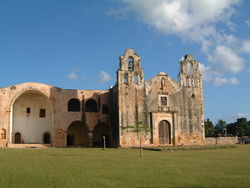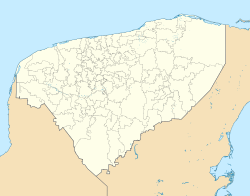Maní, Yucatán
| Maní | |
|---|---|
| City | |

Church and Convent of San Miguel in Maní
|
|
 Location of the municipality of Maní in Yucatán |
|
 The state of Yucatán, México (dark) in the Yucatán Peninsula |
|
| Location of the municipality of Maní in Yucatán | |
| Coordinates: 20°23′N 89°24′W / 20.383°N 89.400°WCoordinates: 20°23′N 89°24′W / 20.383°N 89.400°W | |
| Country |
|
| State |
|
| Government | |
| • Municipal President | Santos Román Dzul Beh. 2012-2015 |
| Elevation | 26 m (85 ft) |
| Population (2010) | |
| • Total | 4,146 |
| Demonym(s) | Maniense |
| Time zone | Central Standard Time (UTC-6) |
| • Summer (DST) | Central Daylight Time (UTC-5) |
| Postal Code | 97850 |
| Area code(s) | 997 |
| Website | www |
Maní is a small city and surrounding municipality of the same name in the central region of the Yucatán Peninsula, in the Mexican state of Yucatán. It is about 100 km to the south south-east of Mérida, Yucatán, some 16 km east of Ticul. The village of Tipikal lies 6 km to the east.
The population is currently around 4000, similar now to the estimated 4500 in the 16th century.
Maní's four millennium existence historically involves mostly its early Maya period, followed in recent centuries by its Spanish conquistador and religious period. Its Mexican period beginning over a century ago involved conflict.
Maní has been continuously occupied for approximately 4000 years. In the postclassic Mesoamerican era it was home to the Tutul-Xiu Maya dynasty, which moved their capital here from Uxmal in the 13th century. The Xiu were the dominant power in the western Yucatán after the fall of Mayapan in 1441. Maní served as the main religious center in honor of the deity Kukulcan (Cukulcan, Topiltzin Quetzalcoatl) for the Maya with an annual chic kaban festival until 1341.
With the arrival of the Spanish the Xiu of Maní allied themselves with the Spanish and assisted in the conquest of the rest of the peninsula.
On July 12, 1562, Friar Diego de Landa, who held the office of inquisitor before the Monastery of San Miguel Arcángel, held an auto de fe Inquisitional cerermony in Maní, burning a number of Maya hieroglyphic books and a reported 5000 idols, saying that they were "works of the devil". The number of books burned is disputed. Landa claimed only burning 27. This act and numerous incidents of torture at the monastery were used to speed the mass adoption of Roman Catholicism throughout the region.
...
Wikipedia

